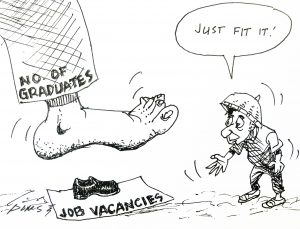Amid the increasing number of individuals acquiring advanced degrees in our country, many are left struggling to find suitable employment opportunities. This predicament of plenty of graduates without available jobs has become a pressing issue, raising concerns about the efficacy of higher education and the country’s ability to utilize its human capital effectively.
One of the primary reasons for the shortage of available jobs for Filipino graduates lies in the demand-supply mismatch. This disparity can be attributed to several factors, including the lack of alignment between academic institutions and labor market needs. In many cases, the curricula do not adequately reflect industry requirements and fail to equip students with the practical skills needed to excel in the workplace. Moreover, the rapid pace of technological advancements renders many traditional fields obsolete, leaving graduates with outdated qualifications. Thus, it is crucial for educational institutions to reassess their programs regularly and foster closer partnerships with industries to ensure that graduates are well-prepared to meet market demands.
The lack of job creation and the limited growth of the country’s economy contributes to this problem. Despite a resilient and promising entrepreneurial spirit among Filipinos, the overall landscape for small and medium-sized enterprises (SMEs) remains challenging. Insufficient access to capital, burdensome bureaucratic processes, and the absence of robust government support hamper the growth and sustainability of businesses, limiting the number of job opportunities available for graduates. Multinational corporations often prefer offshore jobs due to lower costs, further reducing the chances for local graduates to secure employment.
Addressing the issue of graduate unemployment necessitates a comprehensive approach involving policymakers, academia, and private sector stakeholders. The government must play an active role in promoting a business-friendly environment, providing incentives for both local and foreign investments, and improving infrastructure. Additionally, academia should strive to strengthen the link between theory and practice through internships, industry partnerships, and experiential learning opportunities.
The private sector has a responsibility to engage in workforce planning, identifying skill gaps and collaborating with educational institutions to tailor programs that align with industry demands. By fostering this tripartite collaboration, the country can better bridge the gap between graduates and available job opportunities, maximizing the potential of its human capital and driving economic growth.




